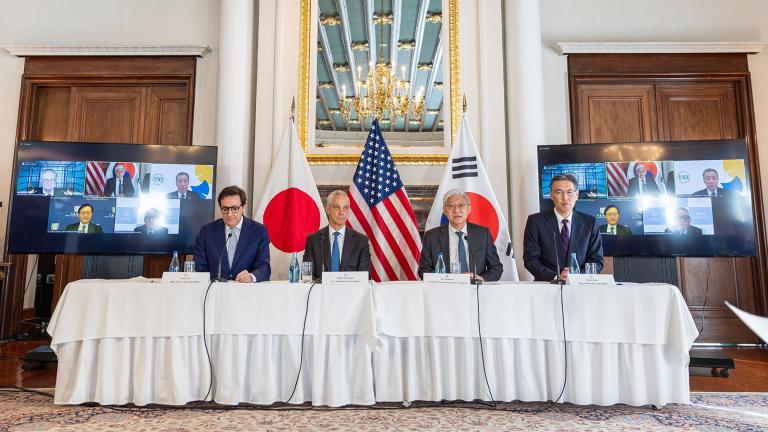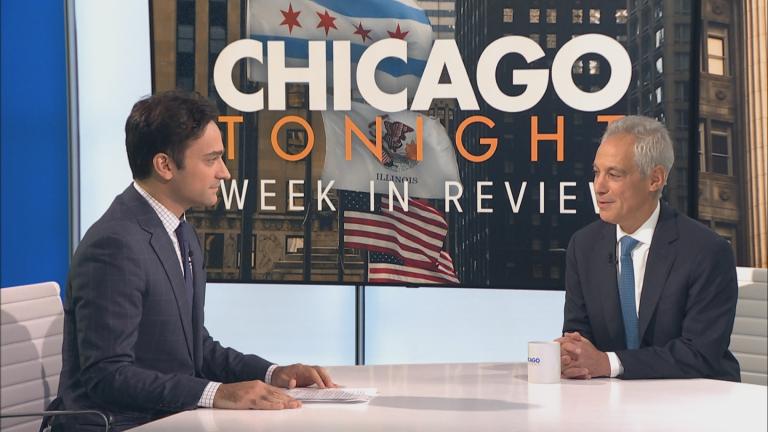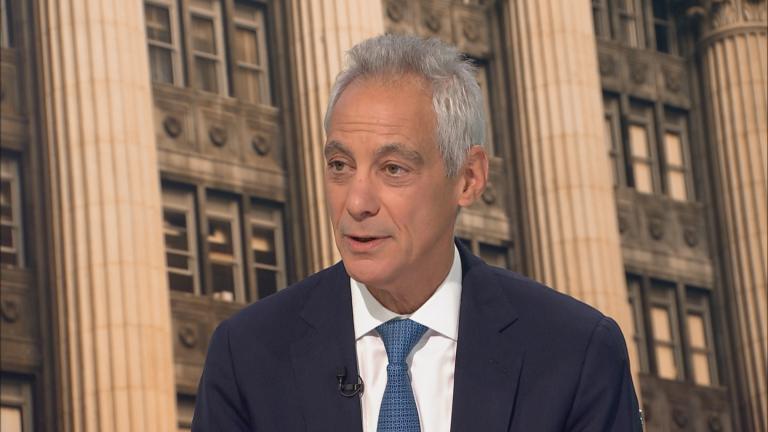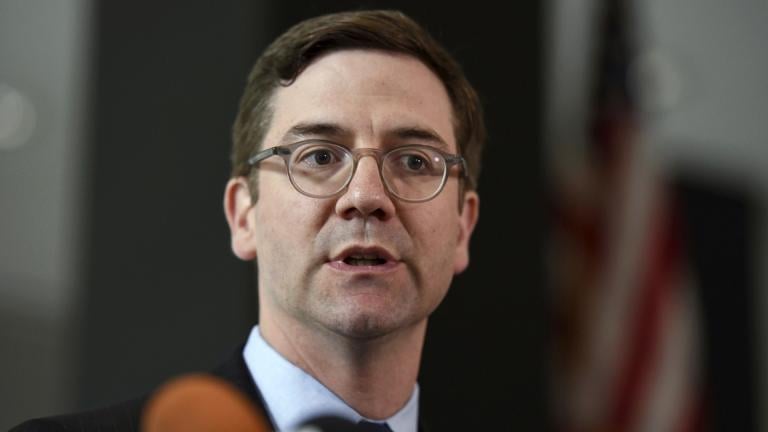Move over, federal government: cities and mayors are where it’s at when it comes to actually getting things done these days.
That’s the premise of a new book by former Chicago Mayor Rahm Emanuel called “The Nation City: Why Mayors Are Now Running the World.”
The book argues that urban centers like Chicago — and the politicians leading them — now set the tone for innovative policies in the U.S. and around the world.
“The center of gravity of our politics have moved local,” Emanuel says. “Not only are mayors in the forefront of the government you have confidence in, that directly touches and effects your life … they’re now taking on other additional pieces of public policy that used to only be the federal government.”
Emanuel says as federal funding has dried up and Congress has grown more dysfunctional, mayors are now tackling national issues like climate change and immigration reform.
“Things that never, ever were the purview of a mayor, they now, to stay ahead and keep their city ahead, have to take on not only the basics of what they always did, but even more because the federal government is retreating, and that void requires they step forward,” Emanuel said.
“The Nation City” features anecdotes and interviews with mayors from around the world about how they addressed problems when the federal government couldn’t, or wouldn’t.
“Ideas now move around the world horizontally and not vertically, as they once did, from the ground up to national governments,” Emanuel writes in the book. “Cities now adopt and adapt ideas and copy and borrow from each other.”
One example Emanuel cites is Chicago’s conversion to LED streetlights.
“We were at a conference on climate change, and Mayor Gregor [Robertson] of Vancouver talked about smart poles and LED lights and other services you can do on those polls. We’re now in the middle of a conversion of all our streetlights [to] LED,” Emanuel said.
The book’s publication comes a month after the Washington Post reported Emanuel had been removed as an unsalaried contributing editor at the Atlantic. Emanuel was pushed off the magazine’s masthead after African American staffers objected to his handling of the murder of Laquan McDonald, which many have called a cover-up. The incident led to the Atlantic eliminating the category of “contributing editor” entirely.
“It was really up to management, I understand their concerns,” Emanuel said, adding he continues to contribute to the Washington Post and Wall Street Journal. “I took that title back – it’s not important. The important thing are the ideas, do they have a forum, and that’s what I’m doing.”
Below, selected excerpts from “The Nation City.”
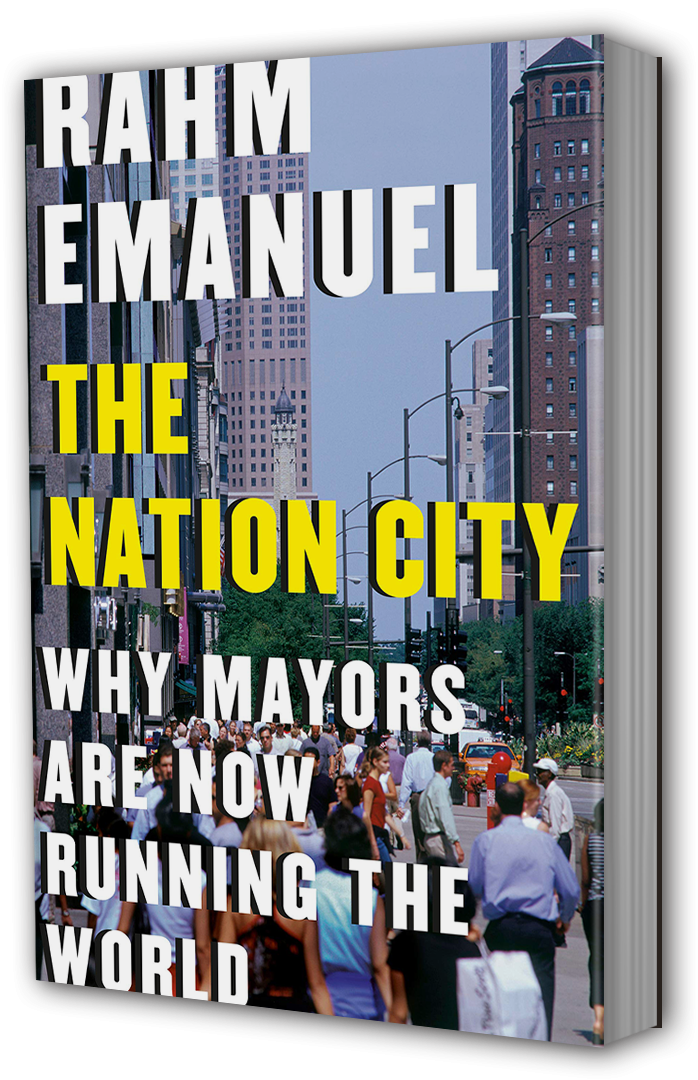 The Nation City: Why Mayors Are Now Running the World
The Nation City: Why Mayors Are Now Running the World
By Rahm Emanuel
Selected Excerpts:
On the Nonpartisan Collaboration and “Idea Stealing” that Makes Mayors More Effective than Congress
When former New York City mayor Michael Bloomberg created a technology hub with partnerships among universities, businesses, and the local government, scores of other cities—including Chicago—decided to do the same thing. Our idea to sue big pharmaceutical companies for deceptive marketing when no one else was really addressing the opioid epidemic caught on quickly. More than seven hundred other cities are now involved in lawsuits. The Riverwalk project we built on the Chicago River was informed by what we saw happening concurrently on the waterfronts of Paris and Berlin and Dallas and Buenos Aires. This idea of repurposing old industrial waterfronts in cities has since spread across the world. Tackling public education as a holistic, prekindergarten-through-college initiative rose nearly simultaneously here in Chicago and in Louisville and Boston. “Good mayors imitate,” says Dayton, Ohio, mayor Nan Whaley. “Great mayors steal.”
These collaborations have proliferated and accelerated “just as the ability of our national politicians to work together has ground to a halt,” says Bruce Katz. Cities, for all intents and purposes, are on their own now. As major deliverers of goods, they don’t have the luxury or patience to wait to solve problems. Cities are collectively plotting independent courses and learning from each other to solve problems. This is happening, as you’ll see, in cities that are large (Chicago), medium (Louisville), and small (Carmel, Indiana). They work together, outside of their respective national governments. They trade goods, ideas, and innovations. They’ve become nation cities.
And here’s another thing that’s going on in cities and with mayors that’s in direct contrast to what’s happening on the national level: Cities and mayors are governing effectively, and they are sharing ideas on a nonpartisan level. Though many of the biggest cities in the world are led by mayors who identify as liberals, many are not. Through the U.S. Conference of Mayors and other intermediaries both domestic and international, we all work together, regardless of political labels. There is a rea- son for this: We all face the same problems, and we all must deal with them immediately. “We maybe come from different broader philosophical ideas about the role of government,” says Tom Tait, the Republican former mayor of Anaheim. “But at the local level it’s about getting things done and serving people. And there’s not a whole lot of ideology in that.” Says Knox White, the Republican mayor of Greenville, South Carolina, “Our federal politicians are in a bubble. We aren’t on the city level, and don’t want to be. We talk to our constituents. We work with each other to get things done. My job is to facilitate this. It’s what I do. That’s what a mayor does.”
Being a mayor is pragmatic and political, but it’s not partisan. It’s about looking forward and not backward. It’s about the locally progressive politics that truly make a positive difference in people’s lives.
Excerpt: On the Leadership of Mayor Pete Buttigieg
Far too often we anoint a young politician as “the next great leader” in politics before said politician is ready or has done anything to deserve such hype. Every once in a while, though, there is a politician who does deserve that hype. One of those people is Pete Buttigieg, the thirty-seven-year-old mayor of South Bend, Indiana.
South Bend is not a big American city. It barely qualifies as a medium-sized one (the population is 102,000). But the quantity of people governed is not the way to measure the effectiveness of a mayor. It is all about the quality of his or her leadership.
Buttigieg was born in the city he governs. He’s a Rhodes Scholar and former McKinsey consultant. He was first elected mayor of South Bend in 2012, becoming the youngest mayor of a U.S. city with at least 100,000 citizens. A year later, while serving as mayor, he was deployed to Afghanistan for seven months as a naval intelligence officer. In 2015, right after he announced his bid for reelection, he came out as a gay man in an op-ed. Four months later he won a second term as mayor with more than 80 percent of the vote.
South Bend is just ninety miles from Chicago (we draw a good number of graduates of the University of Notre Dame, which is in South Bend), so Mayor Buttigieg and I have met on a number of occasions. In the downtown area, you can’t walk ninety feet without running into an alumnus. Mayor Buttigieg likes to describe the job of being mayor as “the hardest and most rewarding job in the world.”
It’s the hardest, he explains, because of the level of scrutiny and immediate accountability. “You can’t offer alternative facts. If a road is in bad shape, you can’t point to it and say, ‘This is the greatest road in the history of roads.’ People will call BS.” He also points out that you’re always on as a mayor. “There is no legislative session and then we all go home for a break,” he says.
But the rewards, Buttigieg says, make it all worth it. “You can get things done. We can be nimble and try different ideas and see what works and what doesn’t. And in a matter of a few years, you can literally see things actually working, people getting jobs and neighborhoods rising. And it’s incredibly rewarding to see that.”
During his tenure Buttigieg has seen a lot of the rewards. Since 2012 the unemployment rate in South Bend has been cut in half and neighborhoods have been reborn, thanks in large part to the transformation of the city under him. Among his successful initiatives was something he called 1,000 Houses in 1,000 Days, in which he pledged to repair or demolish that many buildings to revitalize South Bend. The city was very much in need of a restart when Buttigieg became mayor, full of unsightly and unsafe abandoned and vacant buildings. Both citizens and businesses overwhelmingly backed the initiative.
Buttigieg started the project by basically getting everyone who had a stake— businesses and civic institutions, citizens’ groups, schools, the university, and government entities—in one room and telling them, “Let’s get this done for each other.” He established the deadline of 1,000 days in order to give the plan some needed urgency. It was a critical component. “As the composer Leonard Bernstein once said, ‘In order to do something great, you need two things: a plan and not quite enough time,’” he says.
To add to the pressure and accountability, the city updated the progress of the plan for all to see on its website. “You could see how we fell behind in the middle of the project and then when we caught up,” Buttigieg explains. “It was a healthy combination of pressure and the right kind of reward structure. This is one of the things missing in the federal government.”
Another thing missing in the federal government: actually getting things done. 1,000 Houses in 1,000 Days was completed two months ahead of schedule.
In all, the project cost $10 million. To pay for it, Buttigieg reprogrammed some federal dollars that were earmarked for neighborhood stabilization and applied some of the money from the 2008 mortgage crisis settlement. Repurposing federal money is a critical skill for mayors to cultivate. Creativity from mayors happens on both the idea and the funding side. “There is no deficit spending in cities, no printing of money,” he says. “By law I have to balance the budget every year. We spend down cash reserves some years and borrow money sometimes, but there’s no cheating on whether you have enough money to do what you say you’re going to do.”
This project proceeded hand in hand with another one that was called Smart Streets, which aimed to make the downtown area more accessible and appealing by converting one-way streets into two-laners and then narrowing them (to slow down traffic), widening the sidewalks and making them more aesthetically pleasing (with tree plantings and decorative brickwork), and creating new bike paths. Some fifteen miles of streets were rejuvenated in one year, all done with $24 million in tax increment financing, or TIF, which is a subsidy that is paid back by future tax revenue from that project. Since the project was completed, there has been more than $90 million in private investment in the downtown area, including new hotels, retail stores, and restaurants.
One of Buttigieg’s mandates is never to wait for the federal government to catch up. “We need to act locally and lead by example,” he says. One way he has done this is with paid family leave (new moms and dads get up to six weeks of leave at full salary). “It’s hard to believe that we are the only developed nation without it,” he says. Buttigieg couldn’t impose the measure on the private sector, but he did do it for the 1,000 public employees of the city, leading by example. “Now these folks can turn to their spouses and ask them when their places of work will do the same thing,” he says. “We’ve challenged the rest of the community to catch up.” (Five states and a handful of cities now also offer some sort of paid family leave.)

